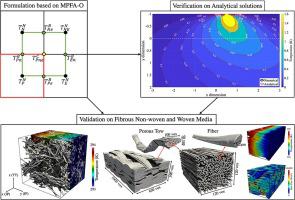当前位置:
X-MOL 学术
›
Comp. Mater. Sci.
›
论文详情
Our official English website, www.x-mol.net, welcomes your feedback! (Note: you will need to create a separate account there.)
Anisotropic analysis of fibrous and woven materials part 2: Computation of effective conductivity
Computational Materials Science ( IF 3.3 ) Pub Date : 2021-01-01 , DOI: 10.1016/j.commatsci.2020.109956 Federico Semeraro , Joseph C. Ferguson , Marcos Acin , Francesco Panerai , Nagi N. Mansour
Computational Materials Science ( IF 3.3 ) Pub Date : 2021-01-01 , DOI: 10.1016/j.commatsci.2020.109956 Federico Semeraro , Joseph C. Ferguson , Marcos Acin , Francesco Panerai , Nagi N. Mansour

|
Abstract Micro-scale modeling enables the study of composite material properties at a fundamental level. These properties must be computed at the scale of a representative elementary volume in order to accurately inform macro-scale response simulations. The main focus of this work is to predict the effective thermal conductivity of anisotropic materials based on the three-dimensional reconstruction of their fibrous structure, obtained from X-ray micro-tomography. A computational method that accounts for multiple scales of anisotropy of woven composites is presented, including that of the constituting fibers and tows, and that of woven architectures. The finite volume formulation and implementation based on the Multi-Point Flux Approximation method is detailed. The algorithm was verified against analytical solutions and validated against experiments on both random and woven fibrous samples. In order to apply the method to real materials, the techniques presented in the first part of this study [1] are used to compute the local material orientation, necessary to align the conductivity tensor along the fibers. The method is ultimately used to reverse engineer the orthotropic conductivity of a single carbon fiber by performing parametric studies and comparing against experiments.
中文翻译:

纤维和编织材料的各向异性分析第 2 部分:有效电导率的计算
摘要 微尺度建模能够从基础层面研究复合材料的特性。必须在具有代表性的基本体积的尺度上计算这些属性,以便准确地通知宏观尺度响应模拟。这项工作的主要重点是基于从 X 射线显微断层扫描获得的纤维结构的三维重建来预测各向异性材料的有效热导率。提出了一种计算方法,该方法可以解释机织复合材料的多个各向异性尺度,包括构成纤维和丝束的各向异性尺度,以及编织结构的各向异性尺度。详细介绍了基于多点通量近似方法的有限体积公式和实现。该算法针对解析解进行了验证,并针对随机和编织纤维样品的实验进行了验证。为了将该方法应用于实际材料,本研究的第一部分 [1] 中介绍的技术用于计算局部材料取向,这是沿纤维对齐电导率张量所必需的。该方法最终用于通过执行参数研究和与实验比较来逆向工程单根碳纤维的正交各向异性电导率。
更新日期:2021-01-01
中文翻译:

纤维和编织材料的各向异性分析第 2 部分:有效电导率的计算
摘要 微尺度建模能够从基础层面研究复合材料的特性。必须在具有代表性的基本体积的尺度上计算这些属性,以便准确地通知宏观尺度响应模拟。这项工作的主要重点是基于从 X 射线显微断层扫描获得的纤维结构的三维重建来预测各向异性材料的有效热导率。提出了一种计算方法,该方法可以解释机织复合材料的多个各向异性尺度,包括构成纤维和丝束的各向异性尺度,以及编织结构的各向异性尺度。详细介绍了基于多点通量近似方法的有限体积公式和实现。该算法针对解析解进行了验证,并针对随机和编织纤维样品的实验进行了验证。为了将该方法应用于实际材料,本研究的第一部分 [1] 中介绍的技术用于计算局部材料取向,这是沿纤维对齐电导率张量所必需的。该方法最终用于通过执行参数研究和与实验比较来逆向工程单根碳纤维的正交各向异性电导率。



























 京公网安备 11010802027423号
京公网安备 11010802027423号